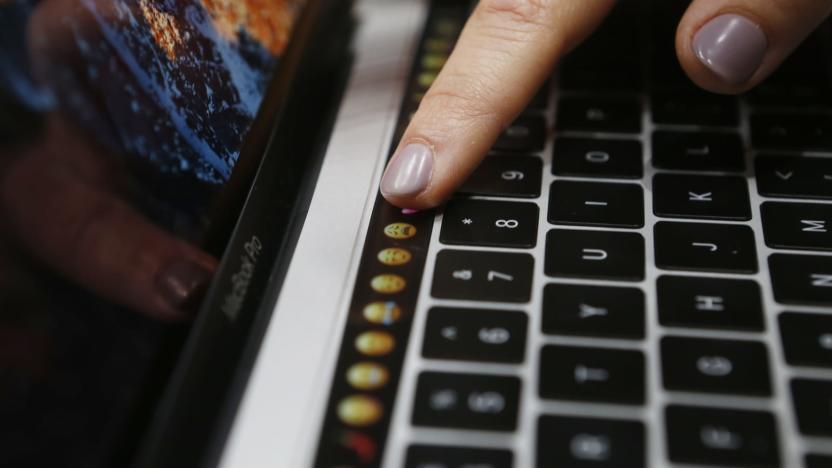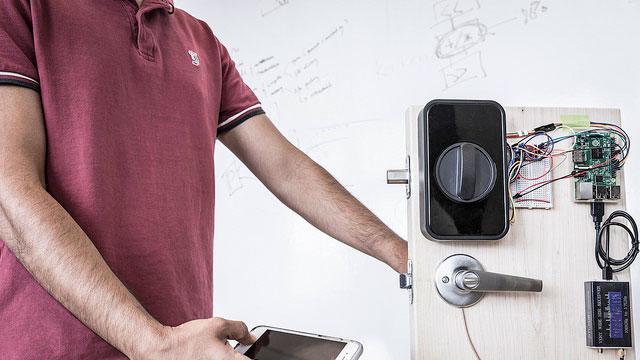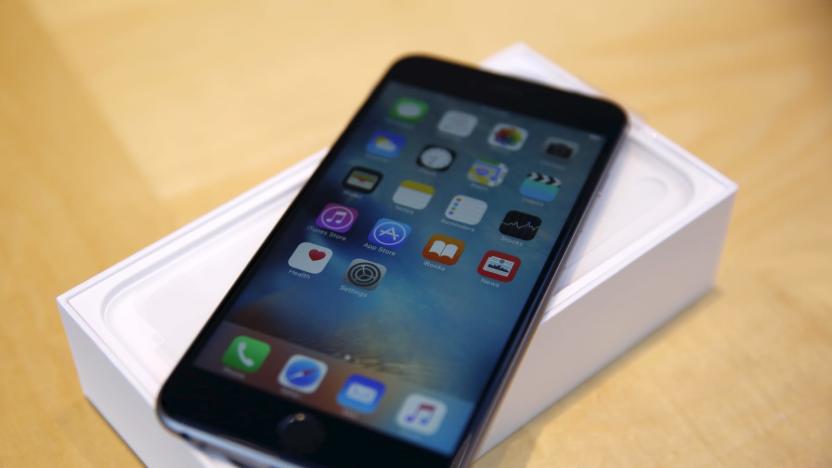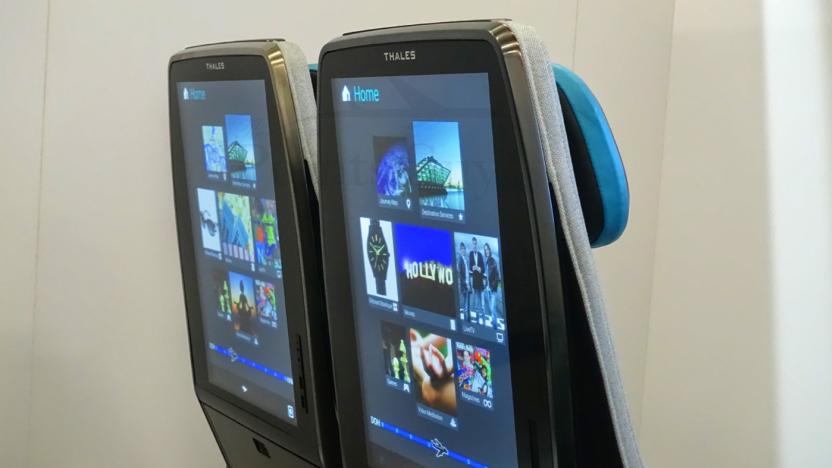touchscreen
Latest

Google's Keep note-taking app lets Chromebook users doodle
Google has added drawing tools to its widely-used note-taking Keep app on Chrome, giving Chromebook users an Android feature that has been around for a year. Spotted by 9 to 5 Google, it's only available via the Chrome Web store, and doesn't work on any browser, including Chrome. You can add a doodle by creating a "new note from drawing," selecting the pen, highlighter or marker tool and choosing from 28 colors and 6 line thicknesses. You can also add a drawing to any existing note with the "add drawing" option.

Nikon's D5600 is a minor update with a focus on connectivity
If you're holding out for a replacement for Nikon's mid-range D5500 DSLR, you may be disappointed with the latest model. The D5600 is a very minor refresh that is obviously intended to act as a stop-gap until an all-new version comes along. Nikon added new wireless capability via NFC and Bluetooth, which gives you a constant connection to your smartphone via the not-very-beloved SnapBridge app. It's also got new options for the 3.2-inch touchscreen, including cropping and a frame-advance bar.

Apple's MacBook Pro isn't the touchscreen laptop it ought to be
Ever since Phil Schiller brought up the issue while introducing the second-generation MacBook Air, Apple has made a point of publicly resisting the pressure to introduce touchscreen Macs. Computers need a fundamentally different interface than your smartphone or tablet, Apple argues, and it's cumbersome to keep raising your hand to the display. However, the new MacBook Pro's Touch Bar really amounts to a confession -- it's an acknowledgment that touch input can improve your computing experience, and that Apple has been missing out on technology that some PC users take for granted. As big a step forward as the Pro may be, it's not necessarily the giant stride that you might like.

The Nintendo Switch reportedly has a multitouch screen
We have plenty of questions about the Nintendo Switch, but one of the most pressing is: Does it have a touchscreen? During the three-minute teaser, no-one ever swipes, taps or prods the main unit, leading to speculation about its capabilities. Well, according to Eurogamer, the hardware does indeed support grubby fingers. The Switch is reportedly rocking a 6.2-inch, 720p capacitive multitouch display -- a first for the company, which has relied on basic resistive touchscreens until now. What's unclear is that how will affect the Switch's docked mode, which covers the display entirely. Lots of alternate control schemes? Possibly.

Researchers use the human body to transfer wireless passwords
Sending data over wireless formats like WiFi and Bluetooth is very convenient, but not necessarily secure. A Princeton report back in January revealed that some smart home devices unwittingly broadcast location information while others didn't encrypt their data streams at all. To get around the uncertainty of pushing information over the air, some scientists have posited using the body as a conduit. Instead of using its magnetic field, as previous researchers have, engineers from the University of Washington have pioneered a way to send wireless signals from a touchpad or screen held in one hand to a smart device in physical contact with the other.

Your iPhone 6 could be falling victim to 'touch disease'
If you've seen a flickering gray bar at the top of your iPhone 6 or iPhone 6 Plus, you may be the victim of a serious problem plaguing your mobile device. According to iFixIt and Forbes, the issue is widespread enough to warrant several pages of complaints via the Apple support forums. The problem is, both the repair techs who continually see the issues coming in and the customers taking to the internet to make their concerns known aren't seeing much done about it.

Dell made a 70-inch touchscreen for schools
Forget chalkboards and whiteboards in the classroom -- Dell thinks tech is the answer. It's launching a 70-inch touchscreen, the C7017T, that's designed to replace interactive whiteboards in schools and boardrooms. You probably wouldn't want this at home given the 1080p resolution, but it can handle 10-finger touch and includes two pens for collaborative sessions. More importantly, it's downright frugal compared to Microsoft's 84-inch Surface Hub. Dell's $5,000 price doesn't include a computer, but it's still going to take a much smaller bite out of the school budget.

Researchers create Rubik's cube-like touchscreen display
While modular smartphones like Fairphone or Google's Project Ara are still works-in-progress, a group of researchers from the University of Bristol's Interaction Group have designed a slick new reconfigurable form for touchscreen displays. The Cubimorph, as BIG calls it, is a single display built out of smaller, six-sided display cubes that are daisy-chained together and can be repositioned not unlike a Rubik's cube with a little more flexibility.

ICYMI: RoboDoc beats humans, touchpad skin and more
#fivemin-widget-blogsmith-image-682998{display:none;} .cke_show_borders #fivemin-widget-blogsmith-image-682998, #postcontentcontainer #fivemin-widget-blogsmith-image-682998{width:570px;display:block;} try{document.getElementById("fivemin-widget-blogsmith-image-682998").style.display="none";}catch(e){} Today on In Case You Missed It: The Smart Tissue Autonomous Robot performed surgery on its own (with a human standing by) and turns out, makes such fine, consistent stitches that it actually beats those done by real counterparts. Carnegie Mellon created a wristwatch display and ring system that makes the skin of your forearm a touch pad to interact with the screen. And McDonald's made something called the McTrax placemat in the Netherland's and music folk everywhere want one, asap. We also rounded up the week's big headlines in TL;DR and hope your weekend conversations touch on whether the UAE should build an artificial mountain to get more rain. As always, please share any great tech or science videos you find by using the #ICYMI hashtag on Twitter for @mskerryd.

Navigate your smartwatch by touching your skin
Smartwatches walk a fine line between functionality and fashion, but new SkinTrack technology from Carnegie Mellon University's Future Interfaces Group makes the size of the screen a moot point. The SkinTrack system consists of a ring that emits a continuous high-frequency AC signal and a sensing wristband that goes under the watch. The wristband tracks the finger wearing the ring and senses whether the digit is hovering or actually making contact with your arm or hand, turning your skin into an extension of the touchscreen.

The future of air travel includes giant seatback displays
Airlines are increasingly embracing mobile devices for in-flight entertainment, and for a good reason -- a tablet is usually much nicer than the cramped, crude seatback systems you normally deal with. Thales thinks the industry can do better, though. It just previewed an in-flight entertainment system, Digital Sky, whose prototype gives each passenger a massive 21.3-inch touchscreen. The portrait orientation leads to some wasted space when you're watching videos, but it can do things that aren't realistic on tinier displays, like serving up the airline's magazine or highlighting things to do at your destination.

Nintendo invents a gamepad dominated by its touchscreen
Nintendo has said precious little about its plans for the NX (other than that it won't be like a Wii U), but it might have hinted at what's coming through some recent paperwork. The console maker has filed for a patent on a gamepad design where a touchscreen would cover the entire front panel. You'd still have familiar elements like analog sticks (poking through the display) and shoulder buttons, but the usual front-facing buttons would be replaced by context-aware touch. The move would give you the adaptability of a smartphone interface with the primary controls you're used to in a TV system -- you could even use the controller on its side, or get visual effects when you press buttons. It wouldn't require a gigantic body like the Wii U's gamepad, either, and a card slot could take game data directly.

Synaptics will bring pressure-sensitive screens to Android phones
Right now, the only way to get a pressure-sensitive screen in a smartphone is to snag an iPhone 6s or wait patiently for the Force Touch version of Huawei's Mate S. You won't have to be quite so picky in the near future, though: Synaptics has unveiled ClearForce technology that brings pressure sensitivity to many phones (read: Android). The tech enables the kind of finger-savvy features you've already seen in the iPhone and Mate S, such as contextual menus and photo zooming, as well as extra tricks like scrolling and choosing special keyboard characters. Synaptics isn't saying just which phone makers like the concept, but "leading" brands should launch their ClearForce devices sometime in the first quarter of 2016.

Gel-filled touchscreen creates real buttons on demand
There's just something about the feeling of physical keys that haptic feedback simply can't replicate on touchscreens. It's part of the reason people buy keyboard accessories for tablets, or Ryan Seacrest's strange iPhone case. It's also inspired some to try to figure out a happy medium between the freedom of touchscreens and the tactile joy of real buttons. Tactus' fluid pocket approach showed promise (the company makes an iPad case that gives the on-screen keyboard a physical presence), but it's ultimately limited by a predefined layout. Now, though, a group of researchers at the Technische Universität Berlin have come up with a way to create soft, temporary buttons of pretty much any shape and size, anywhere on a touchscreen display.

Microsoft's prototype keyboard cover has an e-ink touchscreen
Tablets are becoming more useful for getting real work done. Looking to further bridge the gap between slate and laptop, Microsoft Applied Sciences built a prototype device it calls the DisplayCover: a keyboard cover that houses an e-ink touchscreen display. The 1,280 x 305 resolution panel not only provides access to app shortcuts, but it can also handle touch gestures for navigation and accept stylus input. The stylus feature seems to make things like signing documents and scribbling notes a breeze, based on the demo video. In the case of an app like Photoshop where you need constant access to tool palettes, those items can be parked at the top of the keyboard so they don't take up valuable space on the tablet's display (in this case a Surface).

LG's new touchscreens will make your next laptop thinner and lighter
LG's display subsidiary is promising drastically thinner, lighter touchscreens that will be ready for notebooks later this year. With full HD (1080p) resolution, the Advanced In-Cell Touch (AIT) screens substitute a touch panel layer for a touch sensor built into the LCD itself -- that's what makes it thin. It's the same tech found in smartphones like LG's own G4, but this is the first time it's been sized up to laptops. Thickness savings will be around 25 percent, while weight reductions could be as much as 35 percent compared to typical laptop touchscreen. That reduction in layers also translates to less light reflection, which LG Display reckons will make the new screens brighter and clearer. The company plans to roll out multiple sizes, with stylus-compatible models also on the way. If these screens are going to shave the profile of your next Ultrabook even further, there might be no other choice but to go with a few of those oh-so-slender USB-C ports.

2001 DARPA movie predicts the state of today's technology
Does DARPA employ psychics or something? I mean they must, or how else can you explain this precognitive glimpse at the modern world? The advanced research agency produced it more than a decade ago! Admittedly, many of the ideas featured were already rolling out, in development or pulled from sci-fi, but you can see the futuristic vision (and ugly UIs everywhere) in this DARPA film, Strategic Cyber Defense. Included are a number of modern technologies such as ubiquitous touchscreens, voice activated computer interfaces (a la "Ok Google"), advanced behavioral analysis, real-time translation and automated cyber-defenses. Watch the video below to see how many of today's future technologies you can spot -- and how many are better off left as concepts that didn't pan out.

McDonald's is bringing touchscreen ordering to the US
It turns out that people aren't eating as many McHamburgers as they used to, which is a big problem if your business is all about slinging meat. So McDonald's is hoping the novelty of its "Create Your Taste" ordering kiosks will lure some customers back in. The machines will be installed in 2,000 of its US outlets by the end of 2015. Instead of just walking up to the counter and ordering, users will be given the option to McCustomize their McMeal on a touchscreen. That includes everything from choosing chicken over beef, skipping the fatty mayo or picking sweet potato fries. Unfortunately, the privilege of being able to order a Big Mac minus special sauce on a ciabatta without getting the stink eye will cost you a premium, both in terms of prep time and cash.

When it comes to GoPro's new Hero4 camera, silver is the new black
GoPro cameras have come a long way in the last couple of years. Not only are they a lot smaller (my once "slick" HD Hero2 looks enormous compared to the new Hero4), but also the resolution they can record has finally reached full 30 fps 4K. Not bad considering I don't even own a 4K TV yet. Sure, there are phones that can record 4K, but not with the same versatility and control of an action camera. GoPros have actually recorded 4K (albeit only at 12 fps) since the Hero3, but it's taken until now to deliver a decent frame rate without severely compromising the (already medicore) battery life. This means the company has possibly reached something of a glass ceiling when it comes to its top-billing feature (resolution). Maybe we'll see 8K next year, or 4K at 60 fps, but I honestly feel most of us are a long way from either wanting, let alone needing that. So what's a camera company to do?

Researchers create a virtual screen with touchable objects
A team from the University of Tokyo is putting their own spin on a touchscreen. By combining an infrared sensor with ultrasound technology, the group of researches have managed to design a virtual display that's as thin as air and can let you feel every object you're touching. Dubbed HaptoMime, the project uses a reflective surface to give you that physically tangible feeling, while a change in ultrasonic pressure make it possible to create a number of different sensations -- say you're playing a digital keyboard (like the one pictured above), the feedback from it isn't the same you get with other type of applications. Check out the HaptoMime holographic screen in action after the break.













